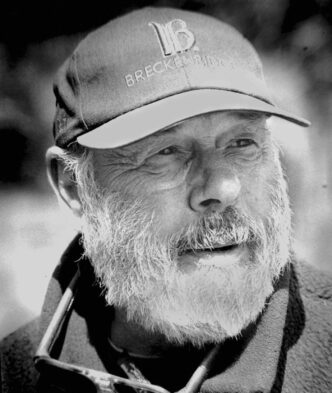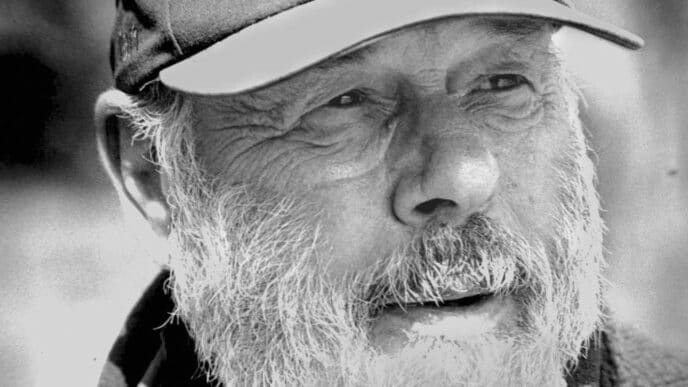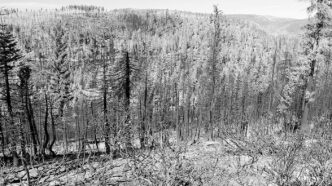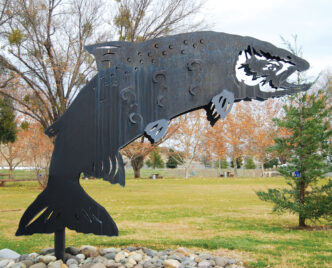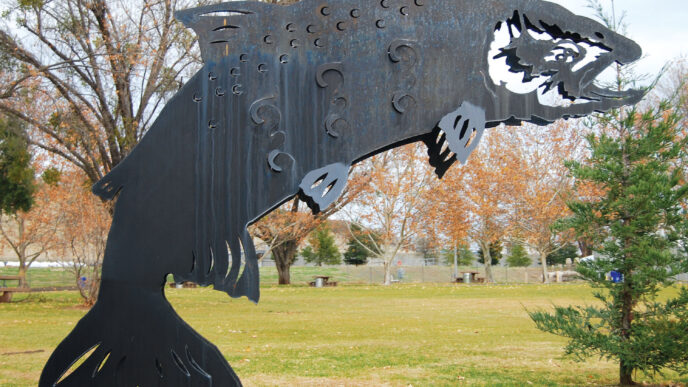It’s a refrain inevitably amplified by age: “If I’d known then what I know now. . .” Topics that follow this statement cover the entire range of human experience, with “married her,” “divorced him,” and “bought Microsoft” currently leading the pack. But let us look at lesser regrets, wistful enough on their own: “loosened the drag,” fished the Eel in ’74,” and “explored more Sierra streams when my knees were still good.”
Most of us have a few of these. What we do with them is where things get interesting — an idea that occurred to me while sitting on a deck above a lake at a party, listening to a mid-twenties guy bemoaning opportunities he’d wasted while attending a university in Montana.
I’ll call him Jerry: “Four years living there near all that great water,” he said. “Barely knew how to fly fish, so never tried. Man, I’d give anything to have that chance again.”
My first thought was to wonder how much of Montana I could buy if I’d bought Microsoft at his age, but I recovered enough to sympathize. And then, later, to wonder: shouldn’t I, at twice his age, have more fishing regrets than the few that barely haunt me?
Oddly enough, I found that question awkward — evidence, I concluded, that I’ve been living an unexamined angling life. “Reflection is good for the soul,” we’re told, along with “Try not to dwell on the past,” which either excludes the same past we’re supposed to learn from or is just another problem with the nature of wisdom. Since Jerry had brought up location, I decided to start there, listing places where I had no doubt missed out.
That proved problematic. I’m not twentysomething, and I belong to a generation that often included a “find yourself ” phase — voluntarily travels, or as part of the draft. Worse yet, I belonged to a “restless wannabe writer” subclass required to wander around collecting the life experiences — known in the craft as “material” — needed to write the next On the Road or maybe a knockoff Hunter S. Thompson, Thomas Pynchon, or Douglas Adams novel.
A time frame, however, would help trim things. I chose “any place where somebody knew to deliver my mail.” Also, since you actually can go home again, I determined that this tearful trail could not always follow a linear track, especially for three decades I spent in California, which I’d lump together to eliminate “then I came back, and left, and came back again.” That left me enough: the southern deserts and northern mountains of Arizona; Pittsburgh, Pennsylvania; northern Israel; central Colorado — mostly the prairie and high desert; Malaysia, the extremes of north and south; and, of course, lots of California: two years plus in L.A. metro, three total, around north-county San Diego, and then a full quarter of a century based on the east side of San Francisco Bay.
So… if I’d known then . . . ?
From ages 6 to 16, I fished Arizona as hard as I could, with tackle including empty orange juice cans to catch mosquito fish in irrigation ditches, bait for bluegills and catfish, lures for bass and trout, a bow for carp where it was legal, and finally, flies. From Encanto Park lagoons to golf course hazards, the Phoenix Zoo ponds, reservoirs on the Salt River chain — Roosevelt and Saguaro when my father would take me or I could hitch rides — add three summers at Whitehorse Lake in the Bradshaws, also Perkins Tank the first year anglers found that it had been secretly stocked by a fly-fishing game warden. The White River on the Apache reservation, the Verde River, East Clear Creek when I was timber thinning….
Regrets?
I certainly could have fished better. At Whitehorse, for example where I worked three summers, every evening, trout rose to a hatch of “mosquitoes” that nobody there, then, knew how to fish, though I tried with my first fly rod, matching the bugs I saw with the only insect-looking pattern
in a circle box of crummy Korean flies. (As noted in this column before, I killed a bat with a back cast, lost the fly, and gave up when none of the others “worked.”)
Regrets? Do agains? Oh yes. White Horse had midges and mayflies. Perkins Tank held oversized rainbows, fat from eating damselflies and dragonflies. I’d fish today from a float tube. And J. D. Dam, another warden project, was a brown trout paradise lost.
Pittsburgh? All those classic Pennsylvania trout streams? I didn’t know anything about them or know anybody who did, and I had no car to get anywhere. I also had other things to do. The second or third night of Carnegie-Melon’s freshman orientation, I met a slender girl who looked f resher than anything possibly could while being jammed into the cave of a frat rush party stinking of beer and vomit. Instead of “What’s your major?” she blurted this out of a clear blue also the color of her eyes: “What I’ll really miss about home is my favorite smallmouth pond, although about this time September, the copperheads are kind of a nuisance.”
“Marry me,” I said. Between her, organic chemistry, and a sudden passion for writing, there went the year.
Vince Marinaro was writing around this time. I’d have liked to meet him, but … let’s move on.
Israel: don’t go for the fishing. The River Jordan was not deep or wide anywhere I saw it, though I’ve read that they now farm trout and salmon on a tributary, the Dan, and if the inshore Mediterranean wasn’t quite dead in those days, it was close enough. I found great diving in the preserve at Eilat — no fishing — and wish I’d snorkeled Sharm el-Sheikh before it changed hands and the Egyptian Army fished the reefs with grenades. I did go to the Kinneret, however, known also as the Sea of Galilee, via a jeeplike rattletrap driven by a cranky kibbutz boss named Dov. His route digressed north to an empty artillery fortification on a lower flank of the Golan Heights below peaks still occupied by Syria. “There,” he said in Hebrew over and over, pointing at some corner or caved-in wall, adding each time the name of a dead friend. He was crying, silently, when we drove down and a puff of dust rose a quarter of a mile to our left, then another about the same distance to our right. “Man ish ma?” I shouted, not from alarm, but because the rattletrap made more noise than the artillery fire. Really.
“The Syrian’s are shelling us,” he said irritably, using English for the first time in the months I’d known him.
“What do we do?”
He shook his head and glared ahead. “Syrians,” he repeated without apparent malice. “Safest place . . . is being right here.”
The next day, I was wading up to my waist surrounded by St. Peter’s fish, an omnivorous variety of tilapia that were rising to midges all around me. I’d never seen fish so innocent. I kept three of a dozen I caught with a hand line and bread balls, but stopped after one took a bait I’d laid on top of my foot, because that felt foolish. As I said, don’t go there to fish, but if you’ve other reasons, take a 5-weight and chironomids.
I returned to northern Arizona. I mention that here, because it was while timber thinning that I first fished and hunted strictly because I needed food; also, because that’s where I learned that bullhead catfish, allowed to overpopulate a pond, will not only take flies, but on occasion a dry fly.
That’s not how I fished them, of course, needing to take two dozen of the 10-inchers — bullheads are mostly head — for two days of meals, but just so you know. My friend Terry and I would kill some bird or mammal, part it out as bait, then use one of the little catfish’s guts to catch cannibal schoolmates.
Pure sustenance stuff. But oddly enough, this was also the first time I released fish that I really did want to eat, a pair of beautiful rainbows and a brown I took from a small stream near another camp south of the Kaibab.
I still don’t regret that, but nearly 40 years later, Terry still hasn’t forgiven me.
Colorado was next, after college, first for a job on the prairie. I should have explored the mountains more, but didn’t, partly because at the end of every long road to a destination — the Blue River, for example, also the South Platte — I found crowds. There were none, however, after hours around the golf course ponds of a South Denver country club where I tended bar, unless you count small bass, perch, and bluegills, and even walleye pike that all took keel-hook-tied streamers I’d bought four for a dollar at a closeout.
I do miss keel hooks, which are hard to find these days. And I would have fished more, and better again — lots — if I’d known somebody who did, or even if John Gierach or Ed Engle had been writing back then. So is Colorado my Montana?
Seems like it should be. But it doesn’t quite feel that way. Malaysia, maybe?
Now, yes, I guess. But back then, no way. Around a Peace Corps training site in Kangar, I took all kinds of fish I’d never seen anywhere before, mostly on bait in muddy jungle rivers and streams. Twice I lost monsters I’d later learn were likely a giant catfish, anomalous because of a frightening set of teeth. I landed five or six other ikan keli catfish species, one species weighing 8 to 10 pounds on average, cobalt blue and anadromous, that swam up to spawn from the South China Sea, another with faintly iridescent skin and fins than ran solid from dorsal to tail and all the way back to its vent. Ikan yu were insectivores, also ikan puyu — imagine a foot-long pale bluegill two inches thick. Ikan harowan, cousins of our bowfin, hunted shallows and flooded paddies at nights for fish, frogs, and small mammals, but so did reticulated pythons, and the one I met late one evening had a head so big I thought I was watching an oversize muskrat swimming toward me in the gloaming. I’m not sure which one of us was most alarmed when we startled each other at 15 feet, only that we both made . . . haste. (The huge tortoise — tortoise, not turtle — I caught while hiking home another dusk was another story.) As fishing tales go, however, the two best came from a stay at a far northern farm to which I was briefly banished. One tale reports a phenomenon, the other a regret.
Eighteen-year-old Rashidi was the farm family’s pariah for failing his exams. Assigned as my “adopted brother,” he fiercely resented that role until I washed Buah, a dog he loved — Muslims cannot touch a wet dog — a task I convinced him required that, per the customs of my country, he grant three wishes. The first was to hold a water buffalo, a kerbau, by the ring in its nose. “No no, too danger,” he insisted, but then acceded. “You bring stick to fish, yes?” he said, then walked me a mile through the jungle to the poorest homestead I’d seen. No father, a mother who looked exhausted, and kids with wary eyes. For giant animals, kerbau are remarkable fearful. This one was, anyway. But a small boy calmed it eventually, and I held the ring in its nose as I stroked its head and horns. Soon after, Rashidi slipped a hand line from his pouch and led the way to a pond I’d noticed not far from the house.
It was something like 50 feet across and almost circular, though not made by man, as far as I could tell. It had neither inlet or outlet, so I presumed it was fed from seepage, but unlike every other Malaysian water I’d seen, its banks were bare of trees and shrubs and dropped off immediately into unknown depths.
I mean really unknown. Casts dropped straight down, even when I lengthened them to cross the pond. Say what? I was thinking when Rashidi produced a bobber of sorts, fixed it three feet above the hook, and passed me a handful of tiny dried shrimp.
The ikan puyu were everywhere, all ranging from medium sized to big. One of the family boys came to fish with Rashidi and me, and there was never a time when at least one of our floats wasn’t dodging or diving. More kids came to the bank, along with their mother. They gutted fish as we caught them, splaying them out on twig drying racks.
At half an hour, I was amazed by a pace that never slowed, an hour later truly astonished.
What is this place? I kept asking. Rashidi only shrugged. So did the boy, but at last said something too soft and accented by dialect for me to understand. “He say like this always,” translated Rashidi. “Or maybe not being always. Sometimes nothing long time.”
I was back to Say what? But half a mile away across dry paddy, I saw tall trees marking a small river that wound along the base of a bukit, one of the most bizarre features of this region. Impossibly narrow hills hundreds of feet high with cliffs almost vertical, bukits look like gigantic butcher knife blades slammed into flat
land. I’d been told they were made of limestone —
— and here I am standing on sand? Anglers of a certain age may remember a Dr. Seuss book titled McElligot’s Pool in which a small boy discovers in a small water an astounding menagerie of fishy beasts that rhyme. If I recall correctly, somehow the adventure ends in the sea.
Maybe McElligot’s pool was also a cenote, those collapsed caverns that pock parts of the Yucatan. Maybe this was, too.
Don’t think I’ll ever know.
And now for the regret. I first saw the most mesmerizing fish I found there one afternoon when Rashidi and I were clinging to tree limbs on opposite sides of the clear little stream that flowed behind his home. The sky was cloudless, for once, but we were safe in shade created by leaf canopy that closed overhead, both of us dangling over the water to fish slender bamboo rods tipped with rice-dough paste. Swarms of fish spread out beneath us, mostly little ikan puyu and yu and carp. Suddenly, I heard a wall of rain approaching — and sometimes it’s truly a wall, dry on one side and drenching wet on the other — splattering loudly against the foliage. It took a moment for that to surprise me: first, because the sky was still brilliant blue, then because just upstream, the water was raining up, splashing silver and white and brown against the lower leaves.
Not water: small fish. Everything in the stream was trying to get out, flying away from slashing boils big enough to be carved by otters.
Not otters: big fish — a school of four or five, each the size and shape of a chinook. The one that swept five feet below me was the color of brass, looked a yard long, and while turning on its side, stared up with a copper eye that looked as large as a quarter.
In that instant, I wanted to catch one of these more than any fish I could remember. But what were they?
“Ikan klee,” said Rashidi, in a voice full of disgust. “Fishing no good now,” he added, already climbing out of his tree.
Catching one was at the top of my remaining two wishes.
We tried. I saw another school once, tearing through another stream so quickly I hadn’t time to rig the rod I carried. Then, the day before I left, as Rashidi and I shared raw peanuts with two boys who’d never met a white man, a sapling in a 10foot-wide trickle nearby went wild, springing the kids into to action.
Imagine a rabbit snare set up with 100-pound test mono and a hook instead of twine and a noose. They’d baited it with a live fish four or five inches long.
An ikan klee it was, though much smaller than the others, just under two feet. In sunlight, the carplike scales looked silver and gold, but its wide mouth, although toothless, was that of a carnivore.
Ikan klee was not in my dictionary, so I asked everywhere. I found out nothing in the few weeks I had left in the north, and nobody near my southern posting in Malaysia seemed ever to have heard the name.
Twenty years later, I was halfway through Somewhere Down the Crazy River, by Paul Arthur Boote and Jeremy John Wade — yes, the host of River Monsters on Animal Planet — describing their hunts for mahseer. Something about those fish sounded familiar, but it was a line suggesting unconfirmed sightings in Thailand — Rashidi’s farm lay two kilometers south of the Thai border — that sent me flipping through the book to a set of photographs sandwiched in the center.
Bingo. And bingo again when a California Fly Fisher reader connected me with a Malaysian angler who identified part of the problem: Rashidi spoke accented dialect. In classical Bahasa, you spell and say it ikan kelah.
Oh, how I wish I’d had a good shot at one of those.
Another regret.
The way I exited Malaysia added others. Though none of the events related to fishing, one left me in a condition ragged enough to take two months of daily fishing to mitigate it. In California, as it happens. So here I am at last, facing the place that is both a state and state of existence that ought to contain more reasons for remorse than all the others combined.
I spent both those two bad months staring at the Pacific, almost as if I could see a woman tending an aged father on the other side of the ocean or imagine the execution of an enemy announced in advance by a letter smuggled through Singapore. I burned brown as swells tugged at a surf rod rigged with a sand crab for corbinas, barred surfperch, and leopard sharks that my father barbequed as steaks, then chunked for shark cocktails. What I looked forward to most during those months, however, were the three nights following full moons — when I thought I knew a California marvel that could lead to angling ecstasy.
Wikipedia will tell you that our grunion are “sardine-sized teleost fish of the Atherinopsidae family of New World silversides,” then describe an “unusual mating ritual whereby at very high tides the females come up on to sandy beaches where they dig their tails into the sand to lay their eggs. The male then wraps himself around the female to deposit his sperm and for the next ten days the grunion eggs remain hidden in the sand.” All correct: in the early 1970s, at least along beaches of northern San Diego County, grunion runs numbered hundreds of thousands of fish that would flash brilliant in breaking waves, then spread across acres of sand to dance in the silver moonlight. Catching these by hand was festival for the few local oldsters who’d taken me out, including one tall old fellow who froze his for bait he’d fish using a single-piece 12-foot split-cane casting rod. But a few years later, while house-sitting in La Jolla, it occurred to me that grunion runs might bring in big fish to hunt them.
This was one out of a hundred hunches that pays off beyond any hopes.
But only if:
The grunion ran.
Nobody spooked the first arrivals that my senior mentors called “scouts.” When you started fishing, the issue was whether your tackle would survive. Fish broke 15-pound and 20-pound test all the time, also a rod, and one night’s monsters ground to nubs the gears of a saltwater spinning reel. I don’t know what species I lost, but I landed sand bass, sometimes even calicos, and white bass — corvinas — at a time when they were rare.
How big?
One evening, I won a San Diego half-day party boat jackpot with a sand bass of four or five pounds. I fished the grunion run on my way home that night, landing three more. The smallest was twice the weight of my money fish, the largest, I’d learn, as big as they grow.
But that was in 1975. Four years later, while fishing my way back to sanity, I just couldn’t find grunion runs, only a few fish here and there. Maybe I had missed spotting them somehow, but locals talked about breakwaters and piers and obstructions that so altered currents that towns had trucked in sand to cover beaches now turned to stones.
Regrets, oh yes. But if I knew all that now, what could I have done differently?
I hope today that I missed grunion runs that still existed, or happened farther south, or north along the beaches at Camp Pendleton, or that if they diminished, they’ve now returned. But recalling those days and the long nights I stalked empty sand almost into the dawn has created a sea change in my attitude. Until then, I’d anticipated reviewing my California fishing life with an almost secret pride. Suddenly, I wondered if it wouldn’t reveal all sorts of wasted opportunities.
It did. In less than half an hour one morning, my “Wish I’d known then” list ran off a page: that I’d fished Russ Chatham’s side of the bay for stripers and beaches down to Pacifica; that I’d fished the Eel and half a dozen other coastal rivers for steelhead, the American more often for browns, the McCloud before the Dolly Vardens went extinct, also a Mount Lassen slope stream that was said still to hold this species into the 1990s, just to catch and clip a fin that might prove they survived. That I’d fished the Feather, again more often, when chinooks were still tyee size; that I’d thrown Clousers to perch from Berkeley rock walls, spent fifty more nights trolling the ponds along 580 before the huge stripers there disappeared. . . .
A litany, this became. Worse yet, it soon struck me that every issue of this magazine contains articles about waters I’d missed fishing and that, given the limits of a lifetime, I never will.
Maybe some sense of mortality had something to do with what I felt. And while I’d like to insist that at some level I knew such woe is fool’s play, I let a feeling of loss arrest my writing all that afternoon, and when a pal called that night to suggest fishing a long-shot creek the next day, I jumped at the chance to escape myself.
“Don’t know much about the stream,” he said, “and can’t find much on the Internet. Middle of nowhere, but I’ve seen stretches from a road and think we should check it out.”
Bright morning, light traffic, and I found 5X tippet at a store on the way. It took us an extra hour to find access, and would have taken more if we hadn’t hailed a rock hound who pointed us to a confluence below which we discovered just enough water in a streambed filled with serpentine and — if you knew how to look, I suppose — agates and other semiprecious stones. Our jewels were trout, however, tiny cutthroats and rainbows that lunged up from depths of 12 inches to take dries and then, in the noon sun, soft hackles from runs the length of a camp cot. We ate smoked salmon and French bread on a white boulder sofa, trekked downstream without breaking bones, and toward evening found the small river that the creek fed. It, too, was an unknown to us, and while the fish were of similar size, they all ate bead heads matching the brilliant blue-green rock worms I seined, save for a 10-inch monster that took a yellow Woolly Worm I tied on for no good reason, really.
I woke up the next day, looked at my woe’s me list, and thought “What a fool.” Worse yet, what an ingrate.
For every California regret I had a dozen reasons to celebrate — meanders I clearly didn’t deserve. So many great waters I’ve fished, so often with great fishers. From the best, I’d even built a guidebook. There was only one idea that I should ponder with real sorrow: that I’d not done enough to help save places when I had the chance.
Or might help to save now.
There we go, I thought. That’s what I’d do differently, and will. It’s not the regrets that matter, but what we do with them.
This meander could end right there. It did for an hour, until over a satisfying tumbler I recalled the conversation with Jerry that started it all.
It hadn’t ended with him saying, “Man, I’d give anything to have that chance again.” He asked me where I’d been fishing lately, apparently presuming an exotic locale. I nodded my head at the lake right beyond the deck.
“Here?” said Jerry. “You fish here?” “Sure. The smallmouths are great, so
are the trout, and those kokanees take flies in the evening.”
“Right here on this lake?”
I laughed. Surprised was one thing, but Jerry looked stricken.
The next day, I found out why, and that reason’s just too special to leave out. Too appropriate, too fitting, I know, but on my honor, true.
“I saw you talking to Jerry last night,” said my daughter, Sophia (which is her real name), at what passed for breakfast. “The young blond guy at the table?”
“Oh sure. Jerry. Went to school in Montana.”
“Right. You met him, like, a long time before that, so don’t recognize him now. He’s Claire’s favorite stepbrother.”
Something nagged at the tag on my brain stem. “Her stepbrother? So . . . that house. That’s —”
“Jerry’s, of course. Or his family’s, anyway. He lived there until he left for college.” On this lake with the dock, boats, bass right off the tules below the lawn, and trout rising to hatches in the evening. “Right here on this lake?” I start to chuckle.
“What’s so funny?” Sophie asks.
“Well. It’s not funny, exactly. More like —”
“Wait. Is this about fishing? Because if it is, I probably don’t want to know.”






